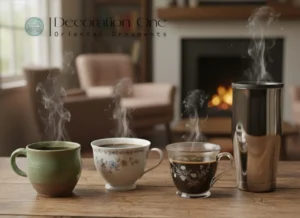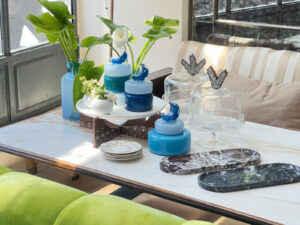
Choosing the right coffee cup is an essential part of enjoying the perfect coffee experience. The material used in the cup affects the flavor, aroma, and heat retention, which makes many people wonder what is a coffee cup made of and how each material differs. Each type of cup provides a unique thermal performance and sensory feel, which ultimately shapes the way coffee tastes. Understanding these materials helps you choose the ideal cup for your preferred style of coffee.
What Is a Coffee Cup Made Of?
The main materials used in making coffee cups
Coffee cups are made from a variety of materials, including ceramic, porcelain, bone china, and stainless steel.
Ceramic has a slightly rough texture and mild absorbency. When the glaze layer chips, the exposed part becomes easily stained and more difficult to clean.
Porcelain is smoother, denser, and resistant to high temperatures, which makes it a popular choice in homes and cafés.
Bone china stands out with its lightweight feel, elegant appearance, and excellent heat retention, while stainless steel is highly durable and ideal for everyday or outdoor use, especially in double-wall designs.
Ceramic vs. porcelain: how each material affects coffee flavor
Although ceramic and porcelain cups are often used for the same purpose, they offer different drinking experiences.
Ceramic provides a warm, traditional feel and works well with dark-roasted coffees thanks to its natural heat distribution and subtle porous structure.
Porcelain, however, is widely preferred for its smooth surface, light weight, and ability to showcase delicate flavor notes. The rounded shape of porcelain cups helps concentrate the coffee aroma, making them a favorite among professional baristas.
Bone china: a premium material with exceptional heat retention
Bone china is considered one of the finest materials used in coffee cups. It is lightweight, smooth, and exceptionally good at retaining heat longer than regular porcelain.
This material is made from refined clay blended with processed animal bone ash, creating a cup with high density and elegant translucency.
Because it keeps coffee warm for an extended period, bone china is commonly used in high-end cafés despite its higher cost compared to other materials.
Stainless steel coffee cups: practical, durable, and ideal for travel
Stainless steel cups—especially double-wall insulated designs—offer excellent thermal retention and strong resistance to breaking or scratching. They are perfect for travel, work, and outdoor use.
Although the metallic feel may not provide the same refined experience as porcelain or bone china, stainless steel remains a top choice for those who prioritize practicality and durability.
Discover now the perfect blend of style and functionality with our premium Coffee Pots
How to choose the best cup for your coffee roast
The ideal coffee cup depends largely on the type of roast you enjoy.
Dark, full-bodied roasts pair well with terracotta and ceramic cups, as these materials preserve heat and highlight the coffee’s rich texture.
Light and specialty coffees, which rely on subtle flavors and fruity notes, are best served in porcelain or bone china, which do not absorb oils or alter the taste.
For travel or long workdays, stainless steel offers the most convenience and heat retention.
Get ready for Ramadan 2026 with our elegant ramadan tableware
Aesthetic vs. practical considerations when choosing a coffee cup
Some cups prioritize beauty, others functionality—while a few combine both.
Ceramic cups offer a classic, handcrafted look that suits traditional settings. Porcelain, on the other hand, provides a modern, elegant appearance ideal for contemporary homes.
Despite the importance of aesthetics, the material plays a bigger role in flavor consistency, heat retention, and overall experience. This is why many coffee experts rely on porcelain and bone china in professional environments.
The evolution of modern coffee cup manufacturing
Coffee cup production has significantly evolved, introducing new designs such as:
-
Double-wall insulated cups
-
Thermal glass cups
-
Portable cups with lids
-
Eco-friendly cups made from plant fibers
These innovations aim to enhance heat retention, increase durability, and provide practical options for different lifestyles. Advances in glazing and high-temperature firing also improved the quality of traditional ceramic and porcelain cups.
Elevate Your Home with Decoration One
Discover the art of elegant living with Decoration One. From luxurious dinnerware and drinkware to stylish serveware, ornaments, and home décor, we provide everything you need to transform your space into a sanctuary of style and sophistication. Whether you’re preparing for festive celebrations, everyday hosting, or special events, our curated collections offer timeless quality and unmatched design. Enjoy international shipping and bring the perfect blend of beauty and functionality to your home with Decoration One. Get ready for Ramadan 2026 and shop our exclusive Ramadan collection
FAQ
Q1: What are the main materials used to make coffee cups?
Coffee cups are commonly made from ceramic, porcelain, bone china, and stainless steel. Each material offers unique heat retention, durability, and drinking experience.
Q2: How does the material of a coffee cup affect the taste and aroma of coffee?
The cup material influences temperature maintenance, aroma concentration, and flavor perception. For example, porcelain highlights delicate notes, while ceramic provides a warm, full-bodied experience.
Q3: Which type of coffee cup is best for dark or specialty roasts?
Dark, full-bodied roasts are ideal in ceramic or terracotta cups, while light or specialty coffees are best in porcelain or bone china to preserve subtle flavors. Stainless steel is perfect for travel or outdoor use.












